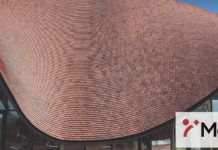 In the past there was a great deal of discussion in the industry about whether to use dry fix or mortar, with manufacturers, like ourselves, advocating the benefits of dry fix systems for roof security and ventilation. When the revised BS 5534 comes into force at the end of the month, this debate will be superseded because the new Standard deems that mortar bedding on its own is not adequate without mechanical fixings. In almost all projects, excluding heritage sites, dry fix is overwhelmingly the best option to meet the BS 5534 changes, so the debate now is not whether to use it, but which dry fix system to use to best meet your project requirements.
In the past there was a great deal of discussion in the industry about whether to use dry fix or mortar, with manufacturers, like ourselves, advocating the benefits of dry fix systems for roof security and ventilation. When the revised BS 5534 comes into force at the end of the month, this debate will be superseded because the new Standard deems that mortar bedding on its own is not adequate without mechanical fixings. In almost all projects, excluding heritage sites, dry fix is overwhelmingly the best option to meet the BS 5534 changes, so the debate now is not whether to use it, but which dry fix system to use to best meet your project requirements.
The growing demand for dry fix systems has led to the market being filled with new products. The most important advice for contractors is to remember that just because something is dry fix, it doesn’t mean it will give you the quality and durability you expect. Unfortunately, there are inferior products available in the market and these may not have all of the performance attributes required by a dry fix system, such as the ability to withstand high wind loads, meet ventilation requirements, effectiveness of the mechanical fit with adjacent tiles, as well as longevity.
In fact, there is such concern about the inconsistency of quality between dry fix products that a British Standards Committee is in the early stages of developing a new standard specifically for dry fix systems. Having been one of the first manufacturers to introduce dry fix more than 30 years ago with our Universal Dry Verge System, this is something we – along with other members of the Roof Tile Association and producers of high quality systems – fully support because it would give contractors and house-builders more certainty over the quality and longevity of the products they are using.
However, unlike BS 5534, the introduction of a new dry fix standard is not imminent and won’t be introduced until the end of this year or maybe even 2016. So in the mean time, how can roofers choose from such a vast array of products to ensure they get the quality and durability they expect from a dry fix system? As with all things in life, price and reputation provide a good indicator of the quality of the system, but cost certainly isn’t the only measure and there are a few things to look out for when buying a dry fix system. To give guidance on what to check, we’ve used dry ridge as an example.
Dry ridge system checklist
As well as traditional dry ridge systems, many contractors are now using quick fix systems where all the components come ready to use in a box; ours is called Universal RidgeFast. There are many different versions available on the market, and they vary significantly in both price and quality, but there are five key components roofers need to consider when choosing a system:
A – Membrane
The membrane gives the flexibility, waterproofing and ventilation required and is arguably the most critical element in terms of performance. Check what the membrane is made from; some products on the market use a polypropylene membrane, mesh fabric or even metal. In our RidgeFast system we use a selected type of synthetic rubber called EPDM, which offers excellent heat, UV, ozone and weather resistance. Using an inferior material can bring down the cost and make the system cheaper to buy, but this could be at the expense of the performance and quality.
We also use EPDM because of its flexibility and stretching properties. This overcomes the problem of rucking which you can get with some other materials. Rucking is where the roll doesn’t lay evenly on both sides and creases up. On other systems, usin




